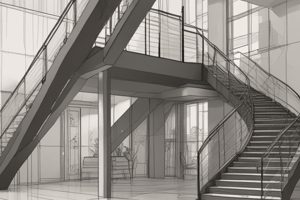Podcast
Questions and Answers
What is the minimum riser height according to the IBC standards for stairs?
What is the minimum riser height according to the IBC standards for stairs?
10 cm
How do you calculate the landing run in a horizontal stair layout, considering the minimum stair width and landing depth?
How do you calculate the landing run in a horizontal stair layout, considering the minimum stair width and landing depth?
The landing run is equal to the minimum stair width, but it should not be greater than 122 cm.
What is the minimum clear head room required in a stairway according to the IBC standards?
What is the minimum clear head room required in a stairway according to the IBC standards?
No specific value is provided in the text, but it is mentioned that the minimum head room will be discussed.
What is the minimum tread depth required in a stairway according to the IBC standards?
What is the minimum tread depth required in a stairway according to the IBC standards?
What type of stair layout requires a minimum stair width of 122 cm for evacuation assistance?
What type of stair layout requires a minimum stair width of 122 cm for evacuation assistance?
What is the correct formula to calculate the number of risers in a stair?
What is the correct formula to calculate the number of risers in a stair?
What is the primary factor that affects the total run of a stair?
What is the primary factor that affects the total run of a stair?
If the depth of tread is increased, how does it affect the total run of a stair?
If the depth of tread is increased, how does it affect the total run of a stair?
What is the correct formula to calculate the total run of a stair?
What is the correct formula to calculate the total run of a stair?
How does the number of landings affect the total run of a stair?
How does the number of landings affect the total run of a stair?
Flashcards are hidden until you start studying
Study Notes
Stair Section Design Guidelines
- Open risers are permitted, but the opening must not allow a 102 mm sphere to pass through.
- Recommendations for steps: minimum tread depth of 33cm, adding riser lights or warning strips, and handrails for visual cues.
IBC Standards for Stairs
- Maximum distance between landing: 366 cm, with a suggested distance of 274 cm (especially for physically disabled people).
- Winder stairs have "pie-shaped" steps substituted for a landing, used when space is limited.
Spiral Stair vs. Curved/Circular Stair
- Spiral Stair:
- Tread Width: 66 cm (min)
- Tread Depth: 19.1 cm (after 30 cm from inner railing)
- Riser Height: 24 cm (max)
- Head Room: 198.1 cm
- Curved/Circular Stair:
- Tread Width: 91.4 cm (min)
- Tread Depth: 28 cm (after 30 cm from inner railing)
- Riser Height: 17.8 cm (max)
- Head Room: 200 cm
Headroom and Stair Nosing
- Headroom: vertical distance above stairs from a line drawn from nosing to nosing to finished upper construction.
- Stair nosing: maximum 30-degree angle.
Handrail Design
- Good gripping is essential; circular shape is best for gripping.
- Handrail clearance: 3.8 cm space between handrail and wall surface with a diameter of 3.2 to 5.7 cm.
Enclosed Exit Stairways and Guards
- Guards help prevent people from falling into floor openings; top portion should discourage sitting.
- Guards are required around unenclosed openings, landings, ramps, and balconies more than 76cm above the floor below.
- Minimum height: 106.7 cm; gap should not be more than 10 cm in between ornamental patterns or intermediate rails.
Stair Design in Horizontal Layout
- Minimum stair width:
- 91.4 cm (for 49 people or less)
- 112 cm (more than 49 people)
- 122 cm (area for evacuation assistance)
- Landing Depth: minimum stair width, but no need to be greater than 122 cm.
- Handrail projection: 11.4 cm (both sides).
- Handrail extension: 30.5 cm (after riser ends and before riser starts).
Stair Design in Vertical Layout
- Handrails must be provided on both sides of the stair (except in residential spaces).
- Minimum handrail height: 86 cm; maximum handrail height: 96 cm.
- Riser height: minimum 10 cm; maximum 17.8 cm.
- Tread depth: minimum 27.9 cm.
- Head room: minimum.
Riser and Tread Relationships
- The relationship between riser and tread can be represented by the formula: 2R + T = 63.5 cm
- This formula shows that the dimension of tread and riser are inversely proportionate
Calculation of Riser and Tread
- When the riser dimension reduces, the tread dimension increases, and vice versa
- Examples of calculations:
- 2R + 30 = 63.5 cm, R = 16.75 cm
- 2R + 33 = 63.5 cm, R = 15.25 cm
- 2R + T = 63.5 cm, with different values of R and T
Calculation for Stair
- Total Run = No of tread x depth of tread + Landing run
- Examples of calculations:
- Total Run = 20x30 + 252.8 = 852.8 cm = 8.528 m
- Total Run = 20x30 + 182.8 = 782.8 cm = 7.828 m
Calculation of Narrow U Stair
- Floor to floor height = 450 cm
- Approximate riser height = 16 cm
- Depth of tread = 30 cm
- Number of user = 40, width of tread = 91.4 cm
- Calculations:
- Number of riser = 28 nos.
- Exact riser height = 16.07 cm
- Number of tread = 25 nos.
- Total Run = 21x30 + 284 = 914 cm
Factors Affecting Total Run of a Stair
- Depth of treads
- Height of risers
- Number of landings
- Floor to floor height
- Examples of calculations:
- Total Run = 21x32 + 284 = 956 cm
- Total Run = 21x28 + 284 = 872 cm
Studying That Suits You
Use AI to generate personalized quizzes and flashcards to suit your learning preferences.




